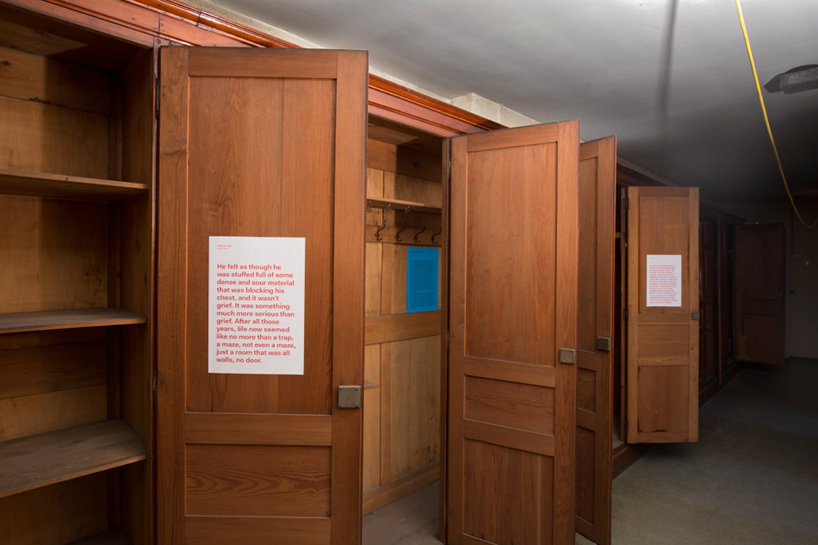joseph grima curates the home does not exist for biennale interieur
the 2014 biennale interieur brings forth a special cultural program which investigates the evolution of the domestic space as a result of economic, social and technological changes. under the invitation of lowie vermeersch, president of the biennale, joseph grima (co-founder of space cavier) took on the challenge of curating a series of interventions that explores our notions of the home in a way that has not previously been addressed; questioning how the role of design has adapted throughout history, and what its function in the contemporary domestic environment is.
lowie vermeersch, president of the biennale interieur on collaborating with joseph grima on the cultural program
video © designboom
under the umbrella theme of ‘the home does not exist’, grima provokes our supposed beliefs and understandings of domesticity. he provides visual stimulation and aggregated data to paint a picture of the realities that have come to defines one’s place of residence, how they inhabit it, and how technology has become an accepted and integrated aspect of the household, its related products and furnishings.
joseph grima on questioning our perceptions of contemporary domesticity
video© designboom
at the heart of the biennale interieur’s Xpo kortrijk site, grima and his team have erected ‘the theatre of everyday life’, an immense metal structure which invites visitors to traverse through its sterile and cold atmosphere. it offers fragments of daily life, as captured from people’s internet and social media behaviors delivered in the form of images, film, music and statistics.
‘where once we decorated our homes to support an exaggerated vision or ourselves for our dinner-party guests, we now compose our identities through a variety of digital media.’ – joseph grima

‘the theatre of everyday life’ positioned in the rambla – the main hall of the biennale interieur site
photo by delfino sisto legnani
addressing ten major themes: the dissident kitchen, the domestic stage set, home schooling, house of the future past, house versus home, mapping the neighbourhood, the right to housing, selling the bedroom, speculation space and storing ownership, ‘the theatre of everyday life’ is a pandemonium of snapshots — propositions and truths — about the domestic space in both historical and contemporary times…

the metal structure is an installation of procoss metal structural elements
image © designboom
the dissident kitchen: how kitchens and other rooms in the home became the site of political revolution or rebellious creation and manufacture.
the domestic stage set: how the home was transformed into a theatre backdrop for broadcasting everyday life to massive audiences online and on TV.

visitors are invited to navigate a landscape of artifacts, drawings, films, photos and information
photo by delfino sisto legnani
home schooling: how the home became ‘smarter’ (and more intrusive into our personal lives) through the invasion of responsive technology.
house of the future past: how the concept and aesthetics of ‘home of the future’ evolved over time, and what it reveals about each era that produced it.

speculation of space and how the home has transformed into a machine for financial profit
photo by delfino sisto legnani
house versus home: the importance of language in establishing what the home is, and the changing mentalities about what defines it.
mapping the neighbourhood: how street and aerial photography and other survey methods have quantified the regions and spaces in which we live.

the kitchen as a site of political revolution or rebellious creation
photo by delfino sisto legnani
the right to house: the rise and fall of public housing from the grand projects post-WWII to the fading of the collective welfare state from society.
selling the bedroom: the end of privacy and the commodification of personal spaces through online communication and sharing platforms.

storing ownership
photo by delfino sisto legnani
speculation space: the home’s transformation from a ‘machine for living’ to a machine for financial profit, and the spatial consequences for cities.
storing ownership: the mass proliferation of possessions due to cheap manufacture, and the rise of storage space as a necessary extension of the home.

data is delivered through lighting installations
photo by delfino sisto legnani
‘for a nomadic generation of millennials, the home and the possessions it contains are no longer of value as an expression of rootedness—on the contrary, such possessions are a ball and chain, and the social function of the dinner party has been displaced by the home as a stage for the expression of a digitally composed self. the home is of value proportionally not to its permanence but for its transience—one apartment amounts to another, and none will last for long.’ – joseph grima

charts and facts on display in ‘the theatre of everyday life’
photo by delfino sisto legnani

alternative view of ‘the theatre of everyday life’
photo by delfino sisto legnani
outside of the main Xpo site, grima delivers a labor intensive exposition in kortrijk’s city centre at the abandoned broelschool. making a call to designers, artists and architects to participate, a final selected team of 20 individuals joined him and space caviar in the broelschol demolition workshop, in which the group, divided into two teams (team dérive and team timeline), inhabited the vacant site from september 23-28th, and reconstructed its interior to offer places for eating, sleeping and working to envision ‘SQM: the quantified home’.
joseph grima on the broelschool demoliion workshop
video © designboom
team dérive took to the physical transformation of the building, constructing alternative routes throughout the interior, with the most noticeable changes being a new staircase and shortcuts through walls and cupboards.

a brand new staircase is one of the major transformations seen as a result of the broelschool demolition workshop
photo by delfino sisto legnani
team timeline on the other hand has developed a graphic layer which covers the existing architecture, that offers a chronological narrative of domesticity over the last 50 years. it is a collection of data, diagrams, graffiti, quotes and way-finding that guide visitors in and out of the school’s nooks and crannies.

the team of approximate 20 people took to the building, utilizing it as a material itself
photo by delfino sisto legnani
as the school is set for complete demolition at the end of the biennale, grima and his team had no restrictions as to what they could do to the structure. they physically employed the building as a construction material itself to carve out a journey for visitors that offers and overview and timeline of domestic space. as a result of broelschool’s impending fate, ‘SQM: the quantified home’ is also a commentary on the regeneration and development of the city itself and the boom of the real estate market, as it is projected to be the site of luxury apartments.

the team had no restrictions as to what they could do with the school and have intervened on its structure
photo by delfino sisto legnani

‘SQM: the quantified home’ presents data and quotes that offer a chronological narrative of the domesticity
photo by delfino sisto legnani

2006 and the launch of the social media era
photo by delfino sisto legnani

quotes throughout the school provoke thought, and bring humor
photo by delfino sisto legnani

data and statistics deliver the realities of the housing market
photo by delfino sisto legnani

the space quantified in numbers
photo by delfino sisto legnani

the building itself is used as a means of delivering data
photo by delfino sisto legnani

photo by delfino sisto legnani
as an homage to the school’s history and to transition it into its final stages of life, the exhibition concludes with a poetically choreographed dance by roomba robots, which once again shows how technology has infiltrated our homes.

‘roomba ballet’
photo by delfino sisto legnani

the domestic robots used for cleaning the floor dance around
photo by delfino sisto legnani
‘the home does not exist’ brings to light the veracity of how the domestic space is no longer confined to a physical area. the exhibition confirms that the places we inhabit are areas that are filled with cultural commentary, in juxtaposition to personal daily rituals, technological dependencies, practical needs, and emotional connections, all converging within an architectural envelope to create what we each independently define as the home.
















biennale interieur 2014 (8)
PRODUCT LIBRARY
a diverse digital database that acts as a valuable guide in gaining insight and information about a product directly from the manufacturer, and serves as a rich reference point in developing a project or scheme.









